
The Victorian period is marked by an important change in the way people viewed art. Artists focused on the imagination of the spectator and began to explore new, challenging subjects. They were attracted by fundamentals of human existence and emotional scenes inspired by legends and mythology. Artists were interested in classification, documentation, and free experiments with new ways of representing the physical world.
Left: Frederic Lord Leighton, Perseus and Andromeda, 1891.
Legend about Perseus killing the Medusa, whose magical power caused all who saw it to be turned to stone, was one the most renowned ancient myths in the Victorian era. Perseus is shown riding on a winged horse. He has come to rescue Andromeda, who is chained to a rock as sacrifice to Poseidon, God of the Sea. Leighton has shown a dramatic moment: Perseus’s arrow has just struck the dragon whose wings are spread over Andromeda.
Helen of Troy by Anthony Frederik Sandys (1867) became the front painting of Victorian Treasures. In the late 1850s and 1860s the artist painted biblical, mythological and literary subjects. He was great friends with Rossetti and frequently found inspiration in his works.
Helen of Troy is connected to an illustration Sandys made for the periodical Once a Week in 1866. Entitled Helen and Cassandra, it showed Cassandra berating Helen as Troy burns in the background. Beautiful Helen chews on a lock of hair in the manner of a spoiled child. The painting portrays the main character inflated, with the same sulky sideways glance and lowered forehead as seen in the illustration.
Left: Anthony Frederik Sandys, Helen of Troy, 1867. Walker Art Gallery.
In the late 19th century Britain experienced an agricultural depression caused by the modernisation of farming practices. The Victorians felt a sense of nostalgia for the idyllic rural life that was at risk of being forgotten. Allingham’s cottage scenes became a way of preserving this pastoral. The artist paid careful attention to styles of architecture and traditional methods of construction.
Misses, an illustration created by Kate Greenaway in 1879, also induced a sense of nostalgia. It shows two elaborately dressed young girls prepared to go out on a winter’s day. The style of their dress would have seemed old fashioned to the spectators in the second part of 19th century. Long fur lined coats and bonnets were a style from the early 19th century. The Victorians felt their life had changed quickly and they enjoyed being reminded of the recent past.
Left: Kate Greenaway, Misses, 1879. Walker Art Gallery.
















